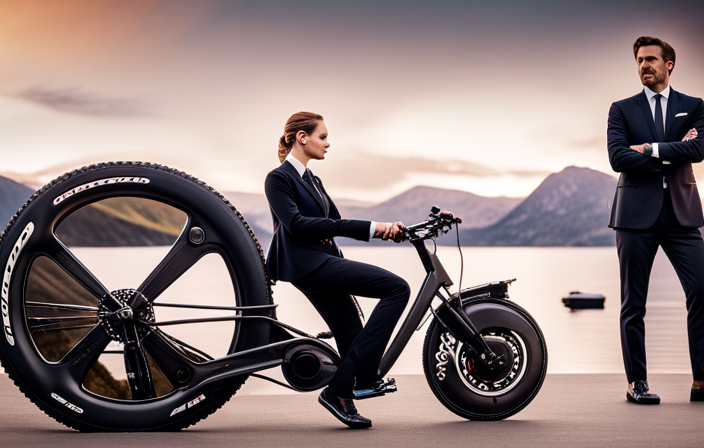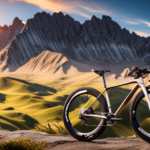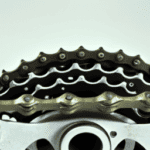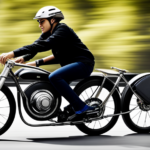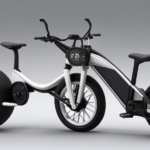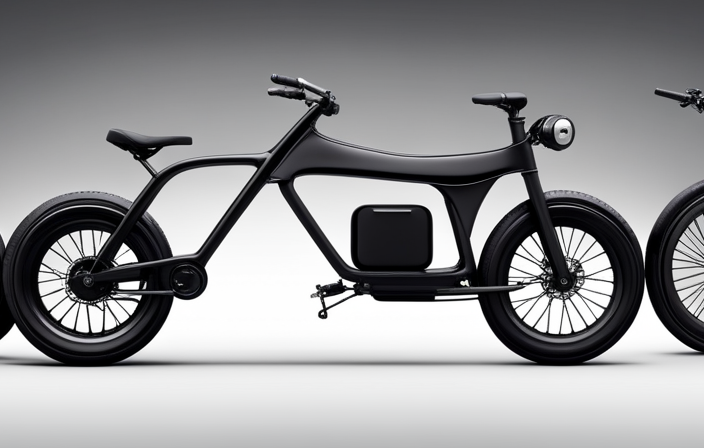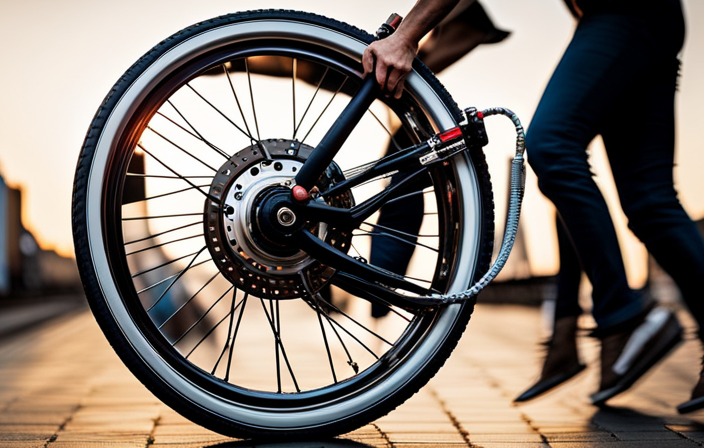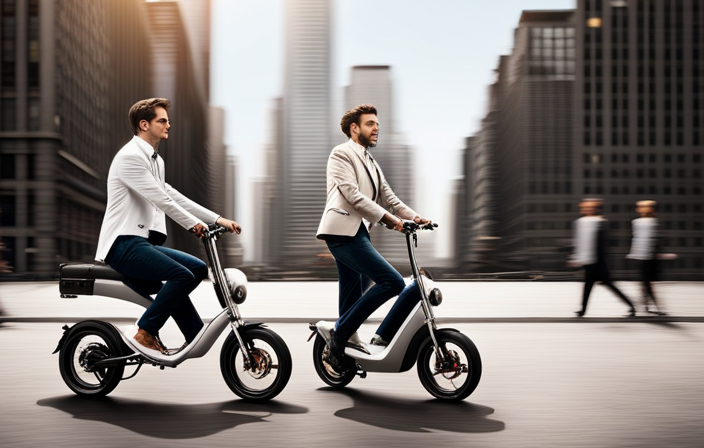As a passionate fan of electric bikes, I am constantly seeking ways to improve my riding experience.
One crucial component that can greatly impact performance is the chainring. It serves as the powerhouse, transferring energy from your legs to the wheels.
But with so many options available, it can be overwhelming to determine which chainring is best suited for your electric bike.
In this article, we will dive deep into the world of chainrings, exploring different types, factors to consider, and ultimately help you make an informed decision that will revolutionize your electric biking journey.
Key Takeaways
- The chainring size determines the gear ratio and should be chosen based on riding style and terrain.
- Different types of chainrings are available for electric bikes, allowing for customization of gear ratios.
- Consider factors such as speed, agility, and comfort when determining your riding style and needs for commuting and urban riding.
- Terrain analysis is important in selecting the appropriate chainring size, with smaller chainrings being suitable for steep gradients and larger chainrings for flat terrains.
Understanding the Purpose of a Chainring
Now, let’s talk about why you need a chainring on your electric bike.
The chainring is an essential component that plays a crucial role in determining gear ratios and evaluating shifting options. It is responsible for transferring power from your legs to the drivetrain, allowing you to pedal efficiently and maintain a desired speed.
By choosing the right chainring size, you can customize the gear ratios to suit your riding style and terrain. This enables you to find the perfect balance between easy pedaling and high-speed performance.
Evaluating shifting options is also important as it ensures smooth gear changes, allowing you to seamlessly transition between different gear ratios.
Understanding the purpose of a chainring is vital in selecting the appropriate type for your electric bike, which we will explore in the next section about types of chainrings for electric bikes.
Types of Chainrings for Electric Bikes
There are different types of chainrings available for e-bikes. The type of chainring you choose will depend on your riding style and the terrain you plan to tackle.
One important factor to consider is the gear ratio. This refers to the number of teeth on the chainring compared to the number of teeth on the rear cassette. A larger chainring size will provide a higher gear ratio, which is beneficial for riding at higher speeds.
On the other hand, a smaller chainring size will give you a lower gear ratio, making it easier to climb hills or navigate rough terrain. Determining your riding style and needs will help you choose the best chainring size for your e-bike.
Determining Your Riding Style and Needs
When it comes to determining your riding style and needs, there are a few key points to consider.
First, if you plan on using your electric bike for commuting and urban riding, you’ll want to focus on factors like speed, agility, and comfort.
For those interested in off-roading and mountain biking, a bike with durable tires, suspension, and a sturdy frame will be essential.
Lastly, if you’re planning on embarking on long-distance touring adventures, you’ll want to prioritize features like battery range, storage capacity, and overall durability to ensure a smooth and enjoyable ride.
Commuting and Urban Riding
If you’re commuting or riding in the city, you’ll want to consider which chainring electric bike is best suited for urban riding. Here are three key factors to keep in mind when it comes to commuting and urban riding:
-
Bike accessories: Invest in essential accessories such as front and rear lights, a bell or horn, and fenders to protect yourself and others from splashes and debris.
-
Safety tips: Always wear a helmet and bright, reflective clothing to increase your visibility. Follow traffic rules, signal your intentions, and be mindful of pedestrians and vehicles around you.
-
Comfort and convenience: Look for features like a step-through frame for easy mounting and dismounting, a rack or basket for carrying items, and adjustable handlebars and seat for a customized fit.
Commuting and urban riding require a reliable and versatile electric bike that can handle different road conditions and provide a comfortable riding experience.
Now, let’s explore the exciting world of off-roading and mountain biking.
Off-Roading and Mountain Biking
Off-roading and mountain biking require a reliable and versatile e-bike that can handle rough terrains and provide an exhilarating riding experience. When it comes to trail selection, it’s important to consider the difficulty level and terrain features.
For off-roading, I look for trails with challenging obstacles like rocks, roots, and steep inclines. Mountain biking, on the other hand, requires trails that offer a mix of technical descents and climbs.
Safety gear and equipment are crucial for both activities. I always make sure to wear a helmet, knee and elbow pads, and sturdy shoes. Additionally, I carry a hydration pack, tools for basic repairs, and a first aid kit.
With the right e-bike, trail selection, and safety gear, off-roading and mountain biking can be thrilling adventures.
Now, let’s transition into discussing long-distance touring without skipping a beat.
Long-Distance Touring
During long-distance touring, it’s important to have a comfortable saddle and padded shorts to prevent discomfort. When it comes to bike accessories for touring, there are a few key items that can greatly enhance your experience.
Here are some essential touring tips to consider:
-
Bike Accessories: Invest in a sturdy bike rack and panniers to carry your gear. These will provide ample storage space and distribute weight evenly, making the ride more balanced and comfortable.
-
Touring Tips: Plan your route ahead of time and carry a detailed map or GPS device. It’s also crucial to pack essential tools and spare parts for any unforeseen mechanical issues that may arise during your journey.
By carefully selecting the right bike accessories and following these touring tips, you can ensure a smooth and enjoyable long-distance touring experience.
Now, let’s shift our focus to considering the terrain and gradient of your route, which plays a crucial role in determining the level of difficulty during your ride.
Considering the Terrain and Gradient
When considering the terrain and gradient, it’s important to choose the right chainring electric bike.
Terrain analysis is crucial in determining the type of bike that will best suit your needs. Whether you’re riding on flat roads, hilly terrains, or tackling steep mountain slopes, understanding the terrain will help you select the appropriate chainring size.
A smaller chainring is ideal for climbing steep gradients, as it provides easier pedaling and more torque. On the other hand, if you’ll be riding on mostly flat terrains, a larger chainring will give you more speed.
Evaluating the gradient is equally important, as it determines the level of difficulty you’ll encounter. Steeper gradients require lower gear ratios to maintain a comfortable pedaling cadence.
Transitioning into evaluating gear ratios and shifting options, one must consider a bike that offers a wide range of gears to handle various terrains and gradients.
Evaluating Gear Ratios and Shifting Options
When considering the terrain and gradient of my electric bike rides, I realized the importance of evaluating gear ratios and shifting options. Having the right gear ratio can greatly impact my performance and efficiency on different types of terrain.
Here are some key factors to consider when evaluating gear ratios and shifting options:
- Range of gear ratios: Having a wide range allows for easier climbing on steep gradients and faster speeds on flat terrain.
- Number of gears: More gears provide finer adjustments, allowing for smoother transitions between gears.
- Shifting mechanism: Options such as trigger shifters or twist shifters offer different levels of convenience and ease of use.
- Compatibility with motor power: Matching the gear ratios to the power output of the electric motor ensures optimal performance.
By carefully evaluating these factors, I can choose the right gear ratios and shifting options that will enhance my riding experience.
Now, let’s explore the next section about balancing speed and power without compromising the overall performance of the electric bike.
Balancing Speed and Power
To achieve optimal performance on your rides, it is important to find the right balance between speed and power. When it comes to electric bikes, this balance can be achieved through a combination of gear ratio and motor assistance.
The gear ratio refers to the relationship between the number of teeth on the front chainring and the number of teeth on the rear cassette. A lower gear ratio provides more power, making it easier to climb hills or ride in challenging terrain. On the other hand, a higher gear ratio allows for greater speed on flat surfaces or downhill sections.
The motor assistance level also plays a key role in finding the right balance. It determines how much power the motor provides, which can be adjusted to match your desired level of exertion.
Assessing the Motor Power and Assistance Levels
When it comes to assessing an electric bike’s motor power output, pedal-assist levels, and throttle control, there are several key points to consider.
Motor power output determines the maximum speed and acceleration capabilities of the bike, with higher wattage motors typically providing greater power.
Pedal-assist levels, on the other hand, determine the level of assistance the motor provides while pedaling, ranging from minimal assistance to full power.
Lastly, throttle control allows riders to engage the motor without pedaling, providing an extra boost when needed.
Understanding these aspects is crucial in selecting the right electric bike that meets your specific needs and preferences.
Motor Power Output
You should consider the motor power output when choosing which chainring electric bike to buy. The motor power output determines the efficiency and torque of the bike, which greatly impacts your riding experience. A higher motor power output generally means a more efficient and powerful ride. To help you visualize the importance of motor power output, consider the following table:
| Bike Model | Motor Power Output |
|---|---|
| Model A | 250W |
| Model B | 500W |
| Model C | 750W |
| Model D | 1000W |
As you can see, the motor power output increases with each model, providing more torque and efficiency. This translates into a smoother and more powerful ride. Understanding the motor power output will help you make an informed decision when choosing the right electric bike for your needs.
Now, let’s discuss the different pedal-assist levels available for chainring electric bikes.
Pedal-Assist Levels
The different pedal-assist levels available for these bikes determine the amount of assistance you receive while riding. Evaluating the efficiency of these levels is crucial in understanding power distribution for an electric bike.
Pedal-assist refers to the system that amplifies your pedaling power, providing a boost as you ride. Most electric bikes offer multiple levels of assistance, typically ranging from low to high. The lower levels provide less assistance, allowing you to exert more effort, while the higher levels give you a greater boost, requiring less effort from you.
By evaluating the efficiency of each level, you can find the optimal setting that maximizes power distribution and conserves battery life. Understanding how these levels work will help you make an informed decision when choosing an electric bike.
Now, let’s transition into discussing the next section about throttle control.
Throttle Control
When it comes to electric bikes, the pedal-assist levels are just one aspect of control. Now, let’s talk about throttle control. This feature allows you to control the bike’s speed with a simple twist of the throttle grip. The throttle sensitivity and response are crucial in determining how quickly and smoothly the bike accelerates.
Here are three key factors to consider:
-
Gradual acceleration: A bike with good throttle sensitivity will provide a smooth and gradual increase in speed, allowing for a controlled and comfortable ride.
-
Instant power: A bike with excellent throttle response will deliver immediate power when you twist the throttle, ensuring a quick and efficient acceleration.
-
Adjustable settings: Some electric bikes offer adjustable throttle sensitivity, allowing you to customize the bike’s response to your preferred level of control.
Considering battery life and range, let’s now explore how these factors play a role in maximizing your riding experience.
Considering Battery Life and Range
If you’re looking for an electric bike with good battery life and range, consider checking out which chainring options are available. The chainring you choose can have a significant impact on the overall performance and efficiency of your electric bike. A chainring is the front sprocket that connects to the pedals and drives the chain. It determines the gear ratios available to the rider, affecting both the top speed and climbing ability of the bike. To help you make an informed decision, here is a table outlining different chainring options and their corresponding effects on battery life and range:
| Chainring Size | Battery Life | Range |
|---|---|---|
| 44T | High | Long |
| 52T | Moderate | Mid |
| 60T | Low | Short |
Compatibility with Your Electric Bike
After considering the battery life and range of my electric bike, it’s important to also think about the compatibility issues when choosing a chainring.
The chainring is a crucial component that directly affects the performance of the bike. It determines the gear ratio and how efficiently power is transferred from the pedals to the wheels.
Different electric bike models may have specific requirements for chainring sizes and designs. It is essential to ensure that the chainring you choose is compatible with your electric bike’s drivetrain system.
Additionally, when comparing performance, consider factors such as the number of teeth, material, and design. These factors can impact the speed, torque, and overall efficiency of your electric bike.
Now, let’s move on to the next section and explore budget considerations when selecting a chainring for your electric bike.
Budget Considerations
To stay within your budget, you should carefully consider the cost of different chainring options for your electric bike. There are several cost-effective options and affordable alternatives available in the market that can help you save money without compromising on quality.
Here are four key factors to consider when looking for budget-friendly chainring options:
-
Material: Opt for chainrings made from durable materials like aluminum or steel, as they are often more affordable compared to carbon fiber or titanium options.
-
Number of Teeth: Consider the number of teeth on the chainring. Choosing a chainring with fewer teeth can be a cost-effective option, as they are generally less expensive.
-
Brand and Reputation: Look for reputable brands that offer affordable chainring options without compromising on performance or durability.
-
Compatibility: Ensure that the chainring you choose is compatible with your electric bike’s drivetrain and other components to avoid any additional costs of modifications or replacements.
By carefully considering these factors, you can find cost-effective chainring options that suit your budget and provide optimal performance for your electric bike.
Seeking expert advice and reviews can further help you make an informed decision without breaking the bank.
Seeking Expert Advice and Reviews
When seeking expert advice and reviews, you can easily gather valuable insights to help you make an informed decision about the most cost-effective options for your budget. Expert opinions provide a wealth of knowledge and experience that can guide you towards the best chainring setup for your electric bike. These experts have tested and analyzed different chainring configurations, allowing them to offer informed recommendations based on performance, durability, and efficiency.
Additionally, customer reviews offer a unique perspective from individuals who have already purchased and tested various chainring setups. Their firsthand experiences can provide crucial insights into the pros and cons of different options. By considering both expert opinions and customer reviews, you can confidently navigate the vast array of choices available and select the chainring setup that best suits your needs and preferences.
Transitioning into the next section, testing and trying different chainring setups allows you to determine the optimal configuration for your electric bike without breaking the bank.
Testing and Trying Different Chainring Setups
You can experiment with various configurations of chainrings to find the most optimal setup for your ride. Testing different gear ratios and comparing chainring materials can help you fine-tune your electric bike’s performance.
Here are three factors to consider when testing and trying different chainring setups:
-
Gear Ratios: Changing the size of your chainrings can affect how your bike accelerates and handles different terrains. Experimenting with different gear ratios can help you find the right balance between speed and torque.
-
Chainring Materials: Different materials, such as aluminum or carbon fiber, can impact the weight and durability of your chainrings. Testing different materials can help you determine which one suits your riding style and preferences.
-
Chainring Size: The size of your chainrings can affect your bike’s overall gearing range. Trying different sizes can help you find the perfect combination for your intended riding conditions.
Considering Future Upgrades and Modifications
Considering possible upgrades and modifications can greatly enhance your riding experience and expand the capabilities of your electric bike. The future of electric bike technology is constantly evolving, with new advancements and features being introduced regularly. If you’re looking to take your electric bike to the next level, here are some modification ideas that you can consider:
| Upgrade/Modification | Description |
|---|---|
| Suspension Fork | Enhances comfort and control on rough terrain. |
| Tubeless Tires | Reduces the risk of flats and improves overall performance. |
| Upgraded Battery | Increases range and allows for longer rides. |
These upgrades can transform your electric bike into a high-performance machine, ready to tackle any trail or road. By investing in these modifications, you can unlock the full potential of your electric bike and enjoy a more thrilling and versatile riding experience. In the next section, we will discuss the importance of maintenance and care for chainrings to ensure optimal performance and longevity.
Maintenance and Care for Chainrings
Taking proper care of your chainrings is crucial to ensure their longevity and optimal performance. This discussion will focus on three key points: cleaning and lubrication, inspection and replacement, and adjustment and alignment.
Cleaning and Lubrication
Cleaning and lubricating your electric bike regularly will help to maintain its performance and extend its lifespan. When it comes to cleaning the chainring, it’s important to inspect it carefully for any dirt, grime, or debris that may have accumulated. To do this, use a clean cloth or a soft-bristle brush to gently wipe away any dirt particles.
It’s also a good idea to check for any signs of wear or damage, such as bent teeth or excessive wear on the chainring. Once the inspection is complete, you can proceed with the cleaning process. There are several chainring cleaning methods available, including using a degreaser and a brush to remove any built-up grease or dirt.
After cleaning, make sure to lubricate the chainring using a high-quality bike lubricant to ensure smooth operation.
In the next section, we will discuss the importance of regular inspection and replacement for maintaining the chainring’s performance.
Inspection and Replacement
To maintain optimal performance of your electric bike, it’s important to regularly inspect and replace worn or damaged components. Here are some inspection techniques and replacement options to consider:
- Visual Inspection: Check for any visible signs of wear or damage, such as cracks, fraying, or rust.
- Functional Inspection: Test the functionality of components, like brakes, gears, and lights, to ensure they are working properly.
- Chain Inspection: Examine the chain for any stretched links, excessive wear, or tight spots.
- Tire Inspection: Inspect the tires for any signs of wear, cuts, or punctures.
- Battery Inspection: Check the battery for any swelling, leaks, or other abnormalities.
If any components are found to be worn or damaged during the inspection, it’s important to replace them promptly. This will help ensure the continued smooth operation of your electric bike.
Moving on to the next section, let’s discuss the adjustment and alignment techniques for your bike.
Adjustment and Alignment
Before you begin adjusting and aligning your components, it’s important to make sure you have the necessary tools.
When it comes to adjustment techniques and alignment methods for your electric bike, there are a few key steps to follow.
First, start by inspecting the chainring for any signs of wear or damage. If necessary, replace it with a new one to ensure optimal performance.
Next, use a chainring alignment tool to check if the chainring is properly aligned with the rest of the drivetrain. Make any necessary adjustments by loosening the bolts and shifting the chainring until it is aligned.
Finally, tighten the bolts securely to hold the chainring in place. With these adjustment techniques and alignment methods, you can ensure that your chainring is in perfect working condition.
Now, let’s move on to making the final decision and purchase of your electric bike.
Making the Final Decision and Purchase
Once you’ve compared all the options, it’s time to make the final decision and purchase the electric bike chainring that best suits your needs.
When making this decision, it’s important to consider the durability and price of the chainring. You want a chainring that will withstand the demands of your riding style and last for a long time.
To ensure durability, it’s recommended to look for chainrings that have been tested for their strength and resistance to wear and tear.
Additionally, comparing prices is crucial to ensure you’re getting the best value for your money. Take the time to research different brands and models, and compare their prices to find the chainring that offers the best combination of durability and affordability.
Frequently Asked Questions
Can I use a chainring from a regular bike on an electric bike?
Yes, you can use a chainring from a regular bike on an electric bike, as long as the bolt pattern and size are compatible. Using a larger chainring can provide more speed, while a smaller one can offer better torque for uphill climbs.
How do I know which chainring size is suitable for my electric bike?
Determining the ideal chainring size for different types of electric bikes is crucial for maximizing efficiency. It’s like finding the perfect gear ratio for a car’s engine; too large or small can impact performance.
What impact does a larger/smaller chainring have on the performance of an electric bike?
A larger chainring on an electric bike provides benefits such as higher top speeds and more efficient power transfer. However, a smaller chainring may result in slower speeds and reduced torque, impacting the bike’s performance negatively.
Are there any specific chainring materials that are better suited for electric bikes?
Using a carbon fiber chainring on an electric bike offers several benefits. It is lightweight, which improves overall bike efficiency. Additionally, the tooth count on the chainring can impact the bike’s efficiency and performance.
Can I change the chainring on my electric bike myself, or do I need professional help?
I can definitely change the chainring on my electric bike myself, but it’s always a good idea to seek professional help if you’re unsure. When it comes to chainring maintenance tips, regular cleaning and lubrication are essential. Upgrading the chainring can improve efficiency and performance.
Conclusion
After thoroughly researching and considering all aspects, I’ve finally made my decision on which chainring to choose for my electric bike. It was a challenging process, but I’m confident in my choice.
As the saying goes, ‘The devil is in the details,’ and I’ve taken every detail into account to ensure the best riding experience.
I can’t wait to hit the road and conquer any terrain with ease. Remember, a well-chosen chainring is the key to unlocking a smooth and enjoyable ride!
